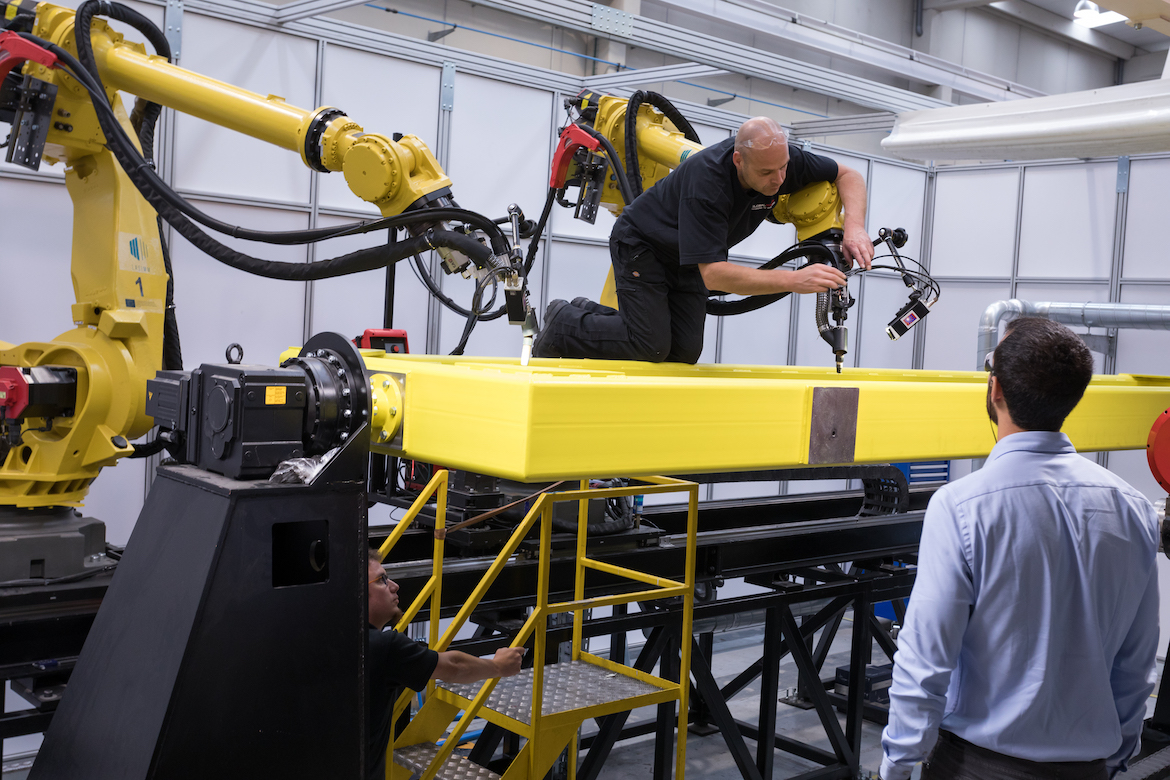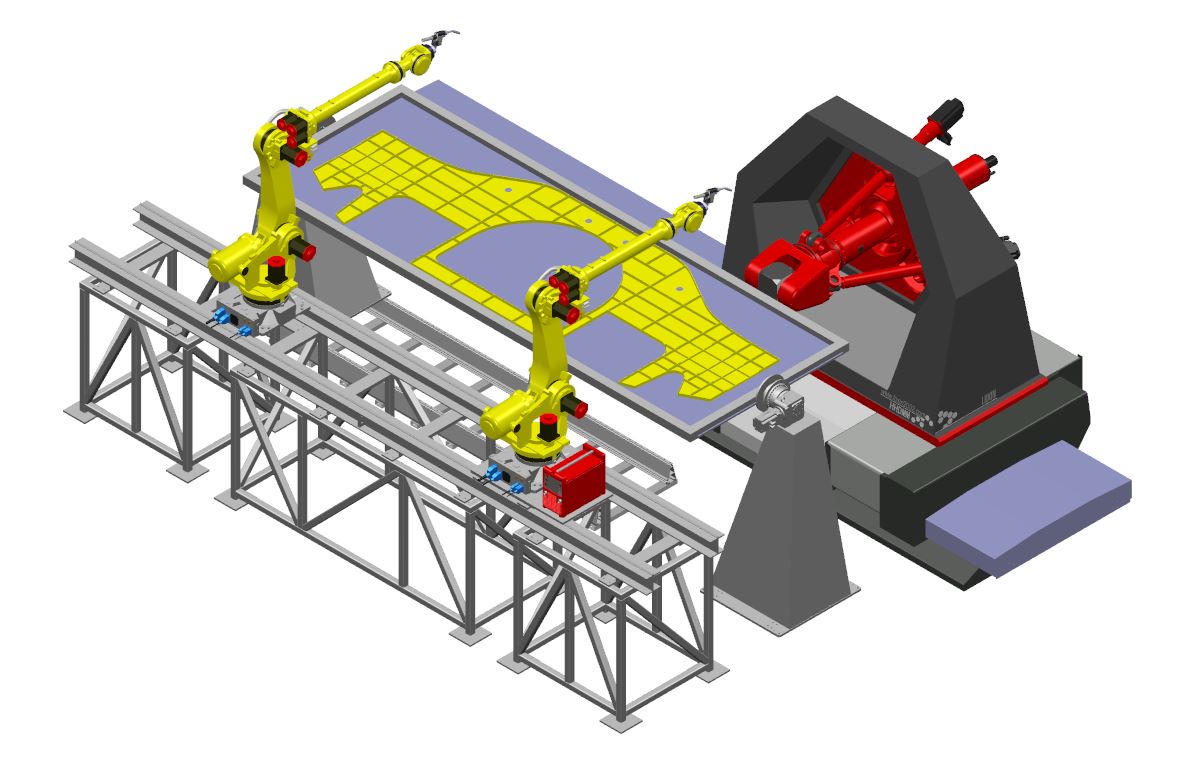LASIMM Hybrid Wire Arc 3D Printing and Milling Robot To Make 6 Meter by 2 Meter Steel 3D Printed Parts

An engineer from Global Robots fine-tunes one of LASIMM’s robotic arms, which is part of the massive 14m x 11m x 5m machine.
Attempting to improve Europe’s industrial competitiveness, the European Union’s Horizon 2020 research and innovation programme has funded one of the world’s largest hybrid manufacturing machine, the Large Additive Subtractive Integrated Modular Machine (LASIMM) project, which has recently announced it was online and ready to start building some mayor construction parts and structures. Housed at Loxin’s facilities in Pamplona (Spain), the machine features some unique metal additive and subtractive capabilities, and has brought together six companies, two universities and two research institutes from different parts of the continent, including Belgium, the UK, Denmark, Spain, Germany and Portugal.
3DPrint.com talked to Eurico Assunção, Deputy Director of the European Federation for Welding, Joining and Cutting and the LASIMM project coordinator, to understand some of the perks of this breakthrough technology. The hybrid manufacturing machine can manufacture end components combining multiple processes, it has unique metal additive and subtractive capabilities and will be capable of 3D printing metal parts and structures for construction as large as six meters by two meters in diameter and upto 2,000 kilograms in weight.
“For the LASIMM project, the hybrid manufacturing capability consists of two different manufacturing processes coming together in one machine: additive (Wire Arc Additive Manufacturing or WAAM process) and subtractive (Machining). The combination will ensure that the machine is capable of achieving the end-user requirements,” Assunção, who is part of the international team of roboticists, software developers and machine engineers making LASIMM possible, told 3DPrint.com.
The machine includes a modular configuration of industrial robot arms for AM of aluminum and steel, and a specialized milling robot for machining away surplus material to provide the final finish. This process will enable entire large-scale industries to move away from standardised components and towards custom-made solutions for businesses in aerospace, energy, transport, and construction, just to name a few.
LASIMM is a European funded project that is still in the research and development phase. Nevertheless, the machine’s capability is being tested to manufacture demonstrator parts for three industrial partners from the aerospace, energy and structure sectors. While the size and efficiency of the development has attracted other companies and according to Assunção, they are now collaborating with them to match their needs with the machine’s correct design. Based on a scalable open architecture framework with associated software that enables full parallel manufacturing, the machine’s capabilities go beyond AM and Machining processes, incorporating cold-work, metrology and inspection.
Launched in 2017, LASIMM can build parts using steel, aluminium, titanium and Inconel. These technologies provide the optimum solution for the hybrid manufacturing of large engineering-grade parts with cost benefits that exceed their conventionally manufactured counterparts by 50%, and deliver a projected 20% reduction in time and cost expenditure, as well as a target 15% increase in productivity for high-volume additive manufacturing production. Other projected benefits include:
- More flexibility and robustness of the machines
- Reduction of inventory
- Reduction of work floor space
- Parallel manufacturing
- Elimination of scrap, resulting in the reduction of waste and thus reduction of cost
- Scalability
- Localized manufacturing environments and reduced supply chains length
- Contribution to standardization and certification for new hybrid procedures
“The LASIMM machine, in its current configuration, can build parts of up to five meters long and two meters wide. Nevertheless, its architecture was developed to be completely modular, meaning that the machine can be configured according to the company and it’s needs. Adding to this, it was designed and built as a “one button” push machine. So, on site, in theory only one person will be needed to setup and run it. It is a very ambitious project with a lot of research and development required, so after overcoming many challenges, some major milestones were achieved which led to a fully operational machine capable of building big parts today.”
For Assunção, his team and the LASIMM consortium that brought together 10 organizations from six different countries, backgrounds and industries, “industrialization was always one of the main objectives of the development”. He explained that with projects like this, “industry is becoming more aware of other metal AM technologies and their capabilities, beyond the development of powder base systems for metals; which is important to ensure that companies choose the right process for their application”.
The partners bringing expertise to the project include the European Federation for Welding, Joining and Cutting, BAE Systems, Foster Partners Limited, Autodesk, Vestas Wind Systems, Cranfield University, Global Robots, Loxin2002, Helmholtz-Zentrum, Geesthacht Zentrum für Material–und Küstenforschung GMBH, and Instituto Superior Técnico.
Other similar endeavors comprise of GE’s laser-powder additive manufacturing machine, one of the world’s largest, built as part of the Project A.T.L.A.S. Program. Or the Wide and High Additive Manufacturing (WHAM), a mammoth-sized additive manufacturing system that will have a build envelop of 23 x 10 x 46 feet, as well as targeted laydown rates of 1,000 lb/hr., built by the government-based national laboratory program, the Oak Ridge National Laboratory (ORNL), and Ingersoll Machine Tools. While Australian company Titomic unveiled last year what it claims is one of the world’s largest metal 3D printer at its fully automated Melbourne facility. The industry is certainly racing to get the biggest AM machines out there, and most of them are quite impressive, countries are trying to advance their industry to produce fully printed huge structures. In this respect LASIMM has brought together a handful of experts from different countries and areas, making it quite a unique project, however a little more time will tell if it will make Europe’s manufacturing sector one of the most competitive in the world.
[Images: Loxin]Subscribe to Our Email Newsletter
Stay up-to-date on all the latest news from the 3D printing industry and receive information and offers from third party vendors.
You May Also Like
Profiling a Construction 3D Printing Pioneer: US Army Corps of Engineers’ Megan Kreiger
The world of construction 3D printing is still so new that the true experts can probably be counted on two hands. Among them is Megan Kreiger, Portfolio Manager of Additive...
US Army Corps of Engineers Taps Lincoln Electric & Eaton for Largest 3D Printed US Civil Works Part
The Soo Locks sit on the US-Canadian border, enabling maritime travel between Lake Superior and Lake Huron, from which ships can reach the rest of the Great Lakes. Crafts carrying...
Construction 3D Printing CEO Reflects on Being Female in Construction
Natalie Wadley, CEO of ChangeMaker3D, could hear the words of her daughter sitting next to her resounding in her head. “Mum, MUM, you’ve won!” Wadley had just won the prestigious...
1Print to Commercialize 3D Printed Coastal Resilience Solutions
1Print, a company that specializes in deploying additive construction (AC) for infrastructure projects, has entered an agreement with the University of Miami (UM) to accelerate commercialization of the SEAHIVE shoreline...































